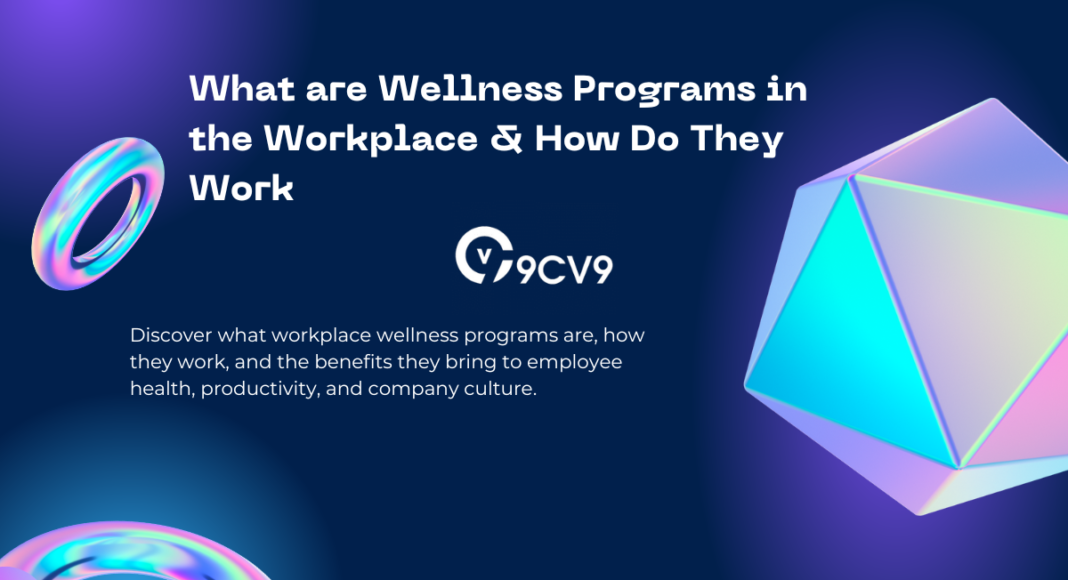Key Takeaways
- Workplace wellness programs enhance employee well-being by focusing on physical, mental, and emotional health, leading to higher productivity and job satisfaction.
- Implementing effective wellness programs can reduce healthcare costs, improve employee engagement, and build a positive workplace culture.
- Key challenges in wellness program implementation include budget management, employee participation, and data privacy, but with careful planning, companies can overcome these obstacles for long-term success.
In today’s fast-paced corporate landscape, the importance of maintaining a healthy, engaged, and productive workforce cannot be overstated.
Companies across the globe are realizing that the well-being of their employees is not just a matter of personal concern but also a critical driver of organizational success.
This shift in focus has led to the rise of wellness programs in the workplace — structured initiatives designed to promote physical, mental, and emotional well-being among employees.
Wellness programs are no longer seen as optional perks or secondary benefits but as essential elements of a thriving workplace culture.
These programs offer comprehensive support to employees, covering a wide range of areas such as fitness, nutrition, mental health, financial wellness, and even stress management.
The primary goal is to help employees improve their overall health, reduce stress levels, and boost morale, all while positively impacting the company’s bottom line.
By implementing wellness programs, companies are not just addressing the immediate health needs of their employees but are also fostering a culture of long-term well-being.
The effects of this approach are profound: healthier employees mean lower healthcare costs, fewer sick days, and higher productivity.
In fact, studies have shown that companies with robust wellness programs report higher employee engagement, better retention rates, and a more vibrant organizational culture.
This trend is being driven by several factors, including a growing awareness of the importance of mental health, the rising cost of healthcare, and the increasing demand for work-life balance.
With employees seeking a holistic approach to their well-being, companies that prioritize wellness are not only enhancing employee satisfaction but also positioning themselves as employers of choice in a competitive job market.
Moreover, wellness programs can be a powerful tool for fostering inclusivity and employee engagement.
By offering programs that cater to diverse employee needs—whether it’s through stress management workshops, fitness classes, or financial wellness seminars—companies can demonstrate their commitment to supporting the whole person.
This, in turn, fosters loyalty and a sense of belonging, which can translate into higher levels of collaboration and innovation in the workplace.
From a broader perspective, wellness programs also contribute to shaping the future of work.
As remote and hybrid work models become more prevalent, the need for virtual and flexible wellness solutions has grown.
Many companies are now integrating digital health tools, online fitness programs, and virtual mental health services to ensure that employees, regardless of their location, can benefit from these initiatives.
This adaptability is key to maintaining a healthy and motivated workforce in a rapidly changing work environment.
In the sections that follow, we will delve deeper into what workplace wellness programs are, how they function, and the transformative impact they have on both employees and employers.
We will explore the different types of wellness programs available, the best practices for implementing them, and real-world examples of companies that have successfully leveraged these initiatives to drive positive change.
Whether you’re an employer looking to improve your wellness offerings or an employee curious about how these programs can benefit you, this comprehensive guide will provide the insights needed to understand the value of wellness programs in the modern workplace.
Before we venture further into this article, we would like to share who we are and what we do.
About 9cv9
9cv9 is a business tech startup based in Singapore and Asia, with a strong presence all over the world.
With over eight years of startup and business experience, and being highly involved in connecting with thousands of companies and startups, the 9cv9 team has listed some important learning points in this overview of What are Wellness Programs in the Workplace & How Do They Work.
If your company needs recruitment and headhunting services to hire top-quality employees, you can use 9cv9 headhunting and recruitment services to hire top talents and candidates. Find out more here, or send over an email to [email protected].
Or just post 1 free job posting here at 9cv9 Hiring Portal in under 10 minutes.
What are Wellness Programs in the Workplace & How Do They Work
- Understanding Workplace Wellness Programs
- How Wellness Programs Work in the Workplace
- Challenges and Considerations in Implementing Wellness Programs
1. Understanding Workplace Wellness Programs
Workplace wellness programs are structured initiatives aimed at supporting and improving the physical, mental, emotional, and sometimes financial health of employees.
These programs have become a cornerstone of modern corporate strategies, as organizations realize that a healthy workforce leads to higher productivity, reduced absenteeism, and improved morale.

In this section, we will break down the essential components of workplace wellness programs, offering a comprehensive understanding of what they entail, why they matter, and how they can be successfully implemented.
What Are Workplace Wellness Programs?
- Definition: Workplace wellness programs are organized efforts by employers to promote healthier lifestyles among employees through various activities, resources, and incentives.
- Examples include fitness challenges, mental health workshops, and smoking cessation programs.
- Purpose: The primary goal of these programs is to support employees’ overall well-being, which, in turn, benefits the organization through higher productivity, reduced healthcare costs, and improved employee retention.
- Scope: Wellness programs cover a broad range of areas, including:
- Physical health (e.g., exercise initiatives, nutrition counseling).
- Mental health (e.g., stress management workshops, mental health days).
- Financial health (e.g., debt management, retirement planning).
- Social well-being (e.g., team-building activities, employee engagement events).
The Rise in Popularity of Wellness Programs
- Growing Awareness of Employee Well-being:
- Employees are increasingly prioritizing work-life balance and health over purely financial compensation.
- Companies with comprehensive wellness programs have become more attractive to top talent, particularly in competitive job markets.
- Healthcare Cost Savings:
- Businesses invest in wellness programs to reduce long-term healthcare costs.
- A study by the Harvard Business Review found that for every dollar spent on wellness programs, medical costs fall by approximately $3.27, and absenteeism costs drop by about $2.73.
Types of Workplace Wellness Programs
Workplace wellness programs come in various forms, each designed to address specific areas of employee health. Below are the key types, along with examples to illustrate how they work in practice.
Physical Wellness Programs
- Description: These programs focus on improving employees’ physical health through fitness, nutrition, and preventive care.
- Common Initiatives:
- On-site fitness facilities: Companies provide gyms or fitness centers at work. Example: Google offers employees access to state-of-the-art fitness centers at their campuses.
- Health screenings: Regular health assessments (e.g., cholesterol, blood pressure checks) help employees monitor their health and catch potential issues early.
- Fitness challenges: Employers encourage participation in challenges like step-count contests or charity runs to foster a culture of health and friendly competition.
- Benefits:
- Reduced risk of chronic diseases (e.g., diabetes, heart disease).
- Lower absenteeism due to improved overall health.
- Increased energy and productivity levels among employees.
Mental Wellness Programs
- Description: Mental health programs aim to reduce stress, anxiety, and burnout while promoting emotional resilience.
- Common Initiatives:
- Stress management workshops: These workshops teach coping mechanisms for managing workplace stress. Example: Accenture runs regular stress management workshops to address mental health challenges.
- Employee Assistance Programs (EAPs): Confidential services that provide counseling and support for personal or work-related issues.
- Mindfulness and meditation sessions: Offering sessions to promote mindfulness and relaxation techniques during the workday.
- Benefits:
- Reduced instances of burnout and stress-related absenteeism.
- Enhanced focus and emotional well-being.
- Better interpersonal relationships within the workplace.
Nutritional Wellness Programs
- Description: Nutritional programs help employees adopt healthier eating habits, which can improve energy levels, prevent disease, and boost overall health.
- Common Initiatives:
- On-site healthy food options: Providing nutritious meal options in the company cafeteria or through catering. Example: LinkedIn offers free, healthy meal options to employees.
- Nutrition education workshops: Seminars that provide information on balanced diets, healthy eating, and meal planning.
- Weight management programs: Support programs aimed at helping employees achieve and maintain a healthy weight.
- Benefits:
- Improved energy and focus during the workday.
- Reduced risk of diet-related illnesses (e.g., obesity, diabetes).
- Positive long-term impact on employees’ overall health.
Financial Wellness Programs
- Description: Financial wellness programs offer resources and support to help employees manage their finances, reduce debt, and plan for retirement.
- Common Initiatives:
- Retirement planning seminars: Sessions that guide employees through the process of preparing for retirement, understanding pensions, and making informed investment decisions.
- Debt management workshops: Programs to assist employees in managing personal debt, improving credit, and saving for the future.
- Financial literacy courses: These courses teach employees about budgeting, saving, and investing. Example: PwC offers a robust financial wellness program that includes workshops and online resources.
- Benefits:
- Reduced financial stress, which can lead to better focus and performance at work.
- Improved financial security and peace of mind for employees.
- Increased employee retention, as workers feel supported in all aspects of life.
How Wellness Programs Benefit Employers and Employees
- For Employers:
- Improved Productivity: Healthy employees are more energized and productive. Reduced absenteeism and presenteeism (when employees are at work but not fully functioning) positively impact the bottom line.
- Lower Healthcare Costs: By promoting preventive care and healthier lifestyles, companies can reduce their healthcare expenditures.
- Enhanced Employee Retention: Employees are more likely to stay with a company that cares for their well-being. This leads to lower turnover rates and the associated costs of recruiting and training new staff.
- Positive Company Culture: Wellness programs foster a sense of community and shared goals, improving collaboration and morale.
- For Employees:
- Better Health and Well-being: Access to resources that promote physical and mental health results in a healthier workforce.
- Work-Life Balance: Wellness programs that focus on mental and emotional health help employees manage stress and avoid burnout, leading to improved work-life balance.
- Increased Job Satisfaction: Employees are more likely to be engaged and satisfied with their jobs when they feel valued and supported by their employers.
The Role of Technology in Workplace Wellness Programs
- Wearables and Fitness Trackers:
- Companies use fitness trackers like Fitbits to track steps, calories burned, and activity levels during company-wide fitness challenges.
- Example: BP America uses fitness trackers to incentivize employees to meet daily physical activity goals.
- Telehealth Services:
- Telemedicine platforms allow employees to access healthcare professionals remotely for mental health counseling, general consultations, or follow-up appointments.
- Online Wellness Platforms:
- Companies can implement digital wellness platforms that offer various resources, such as guided meditation, nutritional advice, and virtual fitness classes.
- Example: Many companies have adopted apps like Headspace and Calm to provide mental health resources on the go.
Workplace wellness programs are comprehensive, multifaceted initiatives designed to support the physical, mental, and emotional well-being of employees.
By addressing various aspects of health and well-being, companies can create a more productive, engaged, and satisfied workforce, while also reducing healthcare costs and improving overall company culture.
As more organizations embrace wellness programs, they continue to evolve, incorporating technology and adapting to the changing needs of the modern workforce.
2. How Wellness Programs Work in the Workplace
Workplace wellness programs function as structured initiatives designed to improve the health and well-being of employees.
These programs are not one-size-fits-all; instead, they are carefully designed based on employee needs, company goals, and available resources.

Successful wellness programs follow a clear process from assessment and design to implementation and continuous improvement. This section explores how wellness programs work in the workplace, covering key steps and strategies that ensure their success.
Assessing Employee Needs and Preferences
Before launching a wellness program, it is essential for companies to understand the specific health and wellness needs of their employees. A tailored approach ensures maximum engagement and effectiveness.
- Employee Health Assessments:
- Conduct surveys or health risk assessments (HRAs) to gather data on employees’ physical and mental health needs.
- Evaluate areas such as stress levels, physical activity, eating habits, and sleep quality.
- Example: A tech company might conduct HRAs to identify stress-related concerns in a high-pressure work environment.
- Focus Groups and Employee Feedback:
- Organize focus groups or meetings to collect feedback on the types of wellness programs employees would value the most.
- Example: A retail company could hold focus groups with different departments to better understand their specific wellness concerns, such as back pain from standing long hours.
- Analysis of Demographic and Job Role Data:
- Consider factors such as age, job roles, and working conditions to tailor wellness offerings. For instance, office workers may benefit from posture improvement programs, while field workers may need physical health initiatives.
- Example: A construction company might emphasize physical wellness due to the demanding nature of the job, offering stretching exercises and regular health screenings.
Designing a Comprehensive Wellness Program
Once a company has gathered relevant data, the next step is to design a wellness program that addresses employee needs while aligning with the organization’s goals.
- Goal Setting:
- Establish clear objectives for the wellness program, such as reducing absenteeism, improving employee morale, or decreasing healthcare costs.
- Example: A financial services firm might set a goal to reduce employee burnout by 20% within a year through stress reduction workshops and mental health resources.
- Program Components:
- Physical Wellness Initiatives:
- Focus on promoting physical health through activities like fitness challenges, walking meetings, and gym memberships.
- Example: A company could sponsor a “10,000 Steps a Day” challenge, encouraging employees to meet daily step goals using fitness trackers.
- Mental Health Support:
- Include stress management programs, access to counseling, and mindfulness training.
- Example: A law firm might provide employees with subscriptions to meditation apps like Calm or Headspace to help manage high levels of stress.
- Nutrition and Lifestyle Support:
- Offer nutritional guidance through workshops, healthy cafeteria options, and weight loss support programs.
- Example: A multinational corporation could provide free access to a nutritionist for personalized dietary advice and host cooking demonstrations.
- Financial Wellness Programs:
- Provide financial planning services, retirement workshops, and debt management resources.
- Example: A software company might host quarterly financial wellness seminars to help employees manage student loans and save for retirement.
- Physical Wellness Initiatives:
- Inclusivity and Customization:
- Ensure the program accommodates employees with diverse needs, including those working remotely or with physical limitations.
- Example: A remote workforce wellness program might include online fitness classes and virtual mental health support to ensure accessibility for all employees.
Implementing the Wellness Program
A well-implemented wellness program requires careful planning, coordination, and communication. Successful implementation ensures employees are aware of and engaged in the program.
- Leadership Involvement:
- Strong leadership support is essential to drive engagement. When executives participate and promote wellness initiatives, employees are more likely to follow suit.
- Example: At Johnson & Johnson, senior leaders actively participate in wellness challenges, setting an example for employees and fostering a culture of well-being.
- Communication and Awareness Campaigns:
- Launch an internal awareness campaign to promote the wellness program and its benefits.
- Use multiple communication channels such as emails, newsletters, posters, and company meetings to keep employees informed.
- Example: A large corporation might introduce its wellness program with a company-wide email followed by regular updates in the corporate intranet, complete with a wellness calendar highlighting upcoming events.
- Creating a Wellness Committee:
- Form a wellness committee with representatives from different departments to oversee the program and encourage participation.
- Example: A healthcare company may create a cross-functional wellness committee that includes HR, employees from various departments, and health experts to ensure the program meets diverse needs.
- Providing Incentives and Rewards:
- Encourage participation by offering incentives, such as cash rewards, extra vacation days, or wellness-related prizes (e.g., gym memberships, fitness equipment).
- Example: A financial services company might reward employees who complete health assessments or participate in fitness challenges with points redeemable for wellness-related products or services.
Employee Engagement and Participation
A wellness program can only succeed if employees actively engage and participate. Creating a culture that promotes health and wellness is key to sustaining long-term involvement.
- Engagement Strategies:
- Offer a variety of programs to suit different interests and fitness levels (e.g., beginner-friendly fitness classes, advanced yoga, or team sports).
- Example: A company might organize a mix of virtual and in-person activities, such as remote meditation sessions and on-site fitness boot camps, to cater to both office and remote employees.
- Utilizing Technology for Engagement:
- Incorporate digital platforms that allow employees to track their wellness progress, set goals, and access wellness resources.
- Example: Fitbit’s corporate wellness program integrates wearable technology with online tracking, allowing employees to monitor steps, sleep patterns, and overall health while competing in friendly challenges with coworkers.
- Regular Feedback and Adjustments:
- Collect feedback through surveys and meetings to understand employee satisfaction with the program and make necessary adjustments.
- Example: A consulting firm might distribute quarterly wellness surveys to gather insights on employee preferences, and use this data to tweak the program offerings.
Monitoring and Measuring the Success of Wellness Programs
Tracking the performance of a wellness program is essential to assess its impact and make improvements where necessary. Companies need to use specific metrics to evaluate the effectiveness of the initiatives.
- Key Performance Indicators (KPIs):
- Common KPIs include employee participation rates, health improvements (e.g., weight loss, reduced stress levels), reduced absenteeism, and healthcare cost savings.
- Example: A company might track absenteeism rates before and after implementing a wellness program to determine whether the initiative is reducing sick days.
- Employee Satisfaction and Feedback:
- Regularly gather employee feedback on the wellness program’s effectiveness and make adjustments as needed.
- Example: A tech startup could conduct bi-annual employee surveys to evaluate the impact of their mental health programs and adjust offerings based on responses.
- Return on Investment (ROI):
- Calculate the program’s ROI by comparing wellness program costs with savings from reduced healthcare expenses and improved productivity.
- Example: A multinational company might analyze the ROI by measuring the decrease in healthcare claims and calculating productivity gains attributed to improved employee well-being.
- Continuous Improvement:
- Regularly update the wellness program to incorporate new health trends, technologies, and employee needs.
- Example: A company may add virtual fitness classes or telehealth services as part of its wellness program to meet the growing demand for remote health solutions.
Real-Life Examples of Successful Wellness Programs
Several companies have successfully implemented wellness programs, setting benchmarks for others to follow.
- Google: Known for its comprehensive wellness offerings, Google provides employees with access to on-site fitness centers, healthy meals, and mental health resources. The company also offers flexible working hours to promote work-life balance.
- Microsoft: Microsoft’s wellness program includes a focus on both physical and mental well-being. Employees have access to on-site fitness facilities, mental health counseling, and paid time off for volunteer activities, fostering both health and community engagement.
- Johnson & Johnson: Johnson & Johnson has been a leader in corporate wellness for decades, offering programs that focus on physical, mental, and financial health. Their program, “Energy for Performance,” encourages employees to focus on nutrition, exercise, and mindfulness to maintain peak performance at work.
The success of a workplace wellness program hinges on its ability to meet the diverse needs of employees while aligning with the organization’s goals.
By carefully assessing employee health needs, designing tailored initiatives, and ensuring proper implementation, companies can create wellness programs that foster a healthier, happier, and more engaged workforce.
Moreover, tracking program performance and making continuous improvements ensures long-term success and sustainability, making workplace wellness programs a vital part of modern corporate culture.
3. Challenges and Considerations in Implementing Wellness Programs
While workplace wellness programs can deliver significant benefits to both employees and employers, implementing these initiatives is not without challenges.
Companies must navigate a range of obstacles, from budgetary constraints to employee engagement issues, in order to create an effective and sustainable wellness program.

In this section, we will explore the key challenges organizations face when implementing wellness programs, as well as critical considerations to ensure long-term success.
Understanding these challenges is essential for designing a program that resonates with employees and delivers measurable outcomes.
Budget Constraints and Cost Management
One of the most significant challenges in implementing wellness programs is budget limitations, particularly for small- and medium-sized enterprises (SMEs). Wellness programs can range from low-cost initiatives, such as health screenings and fitness challenges, to more expensive offerings like on-site fitness centers and comprehensive Employee Assistance Programs (EAPs). Striking the right balance between cost and value is crucial.
- Limited Financial Resources:
- Smaller companies often lack the budget to invest in extensive wellness programs, which can limit the scope and offerings.
- Example: A small tech startup may only have the resources to offer basic wellness initiatives like discounted gym memberships, while larger corporations might offer a full suite of services, including mental health counseling and nutrition programs.
- Cost Justification and ROI:
- Companies must justify the upfront costs of wellness programs by demonstrating a return on investment (ROI) in terms of reduced healthcare costs, lower absenteeism, and improved productivity.
- Example: A manufacturing company might need to assess the impact of a wellness program by tracking healthcare savings over time to justify continued investment.
- Cost-Effective Solutions:
- Low-cost wellness initiatives can still be highly effective. Examples include offering walking meetings, providing healthy snacks in the office, or organizing voluntary fitness challenges.
- Example: Instead of investing in an on-site gym, a midsize firm might collaborate with a local gym to offer discounted memberships to employees.
Employee Engagement and Participation
A common challenge in implementing wellness programs is driving employee engagement. Even the most well-designed programs can fall short if employees do not actively participate or perceive the program as irrelevant to their needs.
- Lack of Awareness or Interest:
- Employees may not be fully aware of the program’s benefits or may not be motivated to participate, especially if they do not see immediate results.
- Example: A financial services firm might implement a comprehensive wellness program, but if employees are unaware of its offerings or how to participate, engagement will remain low.
- Overcoming Resistance:
- Some employees may resist wellness programs due to privacy concerns, skepticism, or the belief that wellness programs are intrusive or irrelevant to their personal needs.
- Example: In a traditional work environment, employees may feel that participating in health assessments or mental wellness programs could lead to judgment or be seen as a sign of weakness.
- Customizing Programs for Employee Interests:
- Offering a variety of wellness initiatives that cater to diverse interests and fitness levels can improve engagement.
- Example: A media company might offer a mix of yoga classes, virtual fitness challenges, and nutrition workshops to appeal to different employees’ interests.
- Incentivizing Participation:
- Providing rewards for participation can boost engagement, such as financial incentives, extra time off, or wellness-related prizes.
- Example: A law firm may introduce a wellness challenge with prizes such as gift cards, fitness equipment, or additional vacation days for employees who actively participate.
Measuring Effectiveness and ROI
Demonstrating the effectiveness of a wellness program is critical for securing ongoing investment and support. However, measuring the impact of wellness programs can be complex, as it often involves tracking a wide range of metrics, some of which may not have immediate or direct financial outcomes.
- Difficulties in Tracking Health Outcomes:
- Improvements in employee health and well-being may take time to become visible, making it difficult to measure short-term success.
- Example: A company offering a smoking cessation program may not see immediate results in reduced healthcare costs or absenteeism, but long-term benefits will eventually emerge.
- Challenges in Quantifying Productivity Gains:
- While wellness programs are designed to improve productivity, quantifying productivity gains can be challenging.
- Example: An organization implementing mental health workshops might find it difficult to attribute specific improvements in employee productivity or engagement directly to the wellness program.
- Collecting and Analyzing Data:
- Gathering meaningful data on employee health improvements, program participation rates, and overall program impact can be resource-intensive.
- Example: A multinational corporation might need to invest in advanced wellness tracking platforms or conduct regular employee health surveys to collect reliable data for analysis.
Privacy and Confidentiality Concerns
As companies collect data on employee health, fitness, and participation in wellness programs, maintaining confidentiality and privacy becomes a critical concern. Employees may be hesitant to participate if they fear their personal health information will be used inappropriately or accessed by unauthorized individuals.
- Health Data Privacy Issues:
- Employees may be wary of sharing personal health information due to concerns about privacy, job security, or discrimination.
- Example: A healthcare provider offering wellness programs must ensure that any data collected from health screenings or fitness trackers is anonymized and securely stored to protect employee privacy.
- Complying with Legal Requirements:
- Employers must comply with privacy laws and regulations such as the Health Insurance Portability and Accountability Act (HIPAA) and the General Data Protection Regulation (GDPR) to ensure that sensitive health data is protected.
- Example: A U.S.-based company must ensure its wellness program complies with HIPAA regulations, particularly if it offers health screenings or shares data with third-party wellness providers.
- Transparency in Data Usage:
- Employers should communicate clearly with employees about how their health data will be used and stored, ensuring transparency and trust.
- Example: A financial services firm may send employees a detailed privacy policy outlining the purpose of data collection, how it will be protected, and who will have access to it.
Cultural and Demographic Differences
Workforces are increasingly diverse, and companies must ensure that wellness programs are inclusive and culturally sensitive. Ignoring cultural differences or failing to account for demographic variations in health needs and preferences can lead to low engagement and dissatisfaction.
- Tailoring Programs to a Diverse Workforce:
- Wellness programs must be flexible and inclusive, taking into account the varying health needs, fitness levels, and cultural practices of employees.
- Example: A global corporation may offer wellness programs that cater to different regions, providing locally relevant fitness activities, mental health resources, and dietary options.
- Addressing Generational Differences:
- Different age groups may have varying preferences for wellness initiatives. Older employees may prioritize preventive care and financial wellness, while younger employees may focus more on physical fitness and mental well-being.
- Example: A tech company may offer a range of wellness options, including retirement planning seminars for older employees and stress management apps for younger employees.
- Cultural Sensitivity in Program Design:
- Certain cultural factors, such as dietary restrictions or preferences for particular types of physical activity, must be taken into account when designing wellness programs.
- Example: A company with a multicultural workforce may offer a range of dietary options in its nutritional programs, including vegetarian, vegan, and halal choices.
Integration with Work Schedules
Workplace wellness programs must be designed to fit into employees’ busy work schedules without causing disruption. If wellness activities are seen as inconvenient or an additional burden, participation rates may suffer.
- Balancing Wellness Programs with Work Demands:
- Employees may struggle to find time for wellness activities, especially in fast-paced or demanding work environments.
- Example: Employees in high-pressure industries such as finance or healthcare may not have the flexibility to participate in on-site fitness classes or wellness workshops during work hours.
- Offering Flexible Wellness Solutions:
- Providing wellness programs outside of regular working hours or offering virtual and on-demand options can increase participation.
- Example: A consulting firm might offer online wellness programs that employees can access at their convenience, including virtual yoga sessions, fitness challenges, and mental health webinars.
- Encouraging Manager Support:
- Managers play a critical role in encouraging participation by allowing flexibility in schedules and setting an example by participating in wellness initiatives.
- Example: In a tech company, managers might actively promote “wellness breaks” during the day, where employees can take time for short walks, relaxation, or meditation without fear of falling behind on work.
Continuity and Long-Term Sustainability
Sustaining wellness programs over the long term is often challenging, as interest may dwindle and organizational priorities may shift. To maintain momentum, wellness programs must evolve and stay relevant to employees’ needs.
- Avoiding Program Fatigue:
- Employees may lose interest in wellness programs if the initiatives become repetitive or fail to provide new and engaging activities.
- Example: A company that runs the same annual step challenge each year might see declining participation unless new elements are introduced to keep it engaging, such as team-based competitions or charitable tie-ins.
- Adapting to Changing Health Trends:
- Wellness programs need to stay current with evolving health trends and technologies, such as incorporating mental health resources, stress management tools, and wearable fitness technology.
- Example: A forward-thinking company might integrate mental wellness apps and virtual fitness platforms as part of their wellness offerings to keep employees engaged.
- Ensuring Leadership Commitment:
- Long-term success requires ongoing support and commitment from leadership. A wellness program that is perceived as a short-term initiative or lacks executive backing may struggle to maintain relevance.
- Example: A retail company with high employee turnover might find it challenging to sustain wellness programs unless leadership demonstrates a strong, long-term commitment to employee well-being.
Implementing workplace wellness programs comes with a variety of challenges, from budgetary limitations to engaging a diverse workforce and ensuring long-term sustainability.
However, with careful planning, thoughtful program design, and continuous evaluation, companies can overcome these challenges to create wellness programs that significantly improve employee health, productivity, and job satisfaction.
Addressing these key considerations early in the process will set the stage for a successful and impactful wellness initiative.
Conclusion
Workplace wellness programs have evolved into essential elements of modern business strategies, offering significant benefits to both employees and organizations.
These initiatives focus on enhancing the physical, mental, and emotional well-being of employees, leading to a healthier, happier, and more productive workforce.
In a competitive business landscape where employee satisfaction, retention, and performance are key to success, wellness programs are no longer optional; they are critical tools for cultivating a thriving workplace culture.
As we have explored, wellness programs are multifaceted, encompassing a wide range of activities and services aimed at improving various aspects of employees’ lives.
From physical fitness and mental health support to financial wellness and stress management, these programs cater to diverse employee needs, ensuring a holistic approach to well-being.
However, creating and implementing an effective wellness program involves more than simply offering a few perks or services.
It requires careful planning, continuous assessment, and a clear understanding of the challenges and considerations involved.
The Core Benefits of Workplace Wellness Programs
- Enhanced Employee Health and Well-Being:
- Wellness programs are designed to help employees improve their health by encouraging healthier lifestyle choices, such as regular exercise, better nutrition, and stress management techniques.
- Programs focusing on preventive care can help employees avoid chronic conditions like obesity, heart disease, and diabetes, leading to reduced healthcare costs for both employees and employers.
- Example: Companies offering on-site fitness centers or discounted gym memberships have seen improved employee fitness levels, which translate into fewer sick days and lower healthcare expenses.
- Increased Employee Engagement and Productivity:
- Healthy employees are more focused, energized, and productive. By addressing issues like stress, burnout, and poor mental health, wellness programs can enhance employee engagement and morale.
- A positive work environment that supports well-being can also lead to higher job satisfaction, reducing turnover and absenteeism.
- Example: Organizations that provide mental health resources and promote work-life balance often experience lower levels of employee burnout and improved overall performance.
- Cost Savings for Employers:
- One of the primary goals of wellness programs is to reduce healthcare costs. By investing in preventive care and supporting healthier lifestyles, companies can significantly reduce the costs associated with medical claims, hospitalizations, and long-term health issues.
- Additionally, wellness programs can decrease absenteeism and presenteeism, saving companies money through increased employee availability and performance.
- Example: A manufacturing company that implements a wellness program focusing on reducing workplace injuries may see a decrease in workers’ compensation claims, leading to significant cost savings.
- Building a Positive Corporate Culture:
- Wellness programs contribute to creating a workplace culture that values employee well-being. When employees feel supported and valued, they are more likely to remain loyal to the company, contribute to a positive work environment, and collaborate effectively with their colleagues.
- Companies that prioritize employee health are often viewed as more attractive employers, which can improve recruitment and retention efforts.
- Example: Global corporations like Google and Microsoft, known for their comprehensive wellness programs, have successfully cultivated a positive workplace culture, contributing to their reputation as desirable places to work.
Overcoming Challenges in Wellness Program Implementation
While the benefits of wellness programs are clear, implementing them effectively can be challenging.
Organizations must address several key obstacles, such as budget constraints, employee engagement issues, privacy concerns, and cultural differences, to ensure success.
A well-designed wellness program that is tailored to the needs of the workforce and supported by leadership can overcome these challenges and yield lasting results.
- Budget Considerations:
- Companies must balance the costs of wellness initiatives with the anticipated return on investment (ROI). Smaller businesses, in particular, may face limitations in offering expensive wellness options, but cost-effective alternatives such as fitness challenges, health education, and digital wellness platforms can still provide substantial benefits.
- Employee Engagement:
- A successful wellness program relies on high levels of employee participation. Companies must focus on designing inclusive programs that cater to the diverse interests and needs of their workforce. Providing incentives, promoting awareness, and integrating wellness activities into daily routines can enhance engagement.
- Privacy and Trust:
- Privacy concerns regarding health data must be addressed to build trust and encourage participation. Ensuring compliance with relevant privacy laws and maintaining transparency in how data is collected and used are vital components of a successful program.
- Cultural Sensitivity:
- An inclusive wellness program recognizes and accommodates the diverse needs of employees, including generational differences, cultural backgrounds, and varying health concerns. Tailoring wellness offerings to reflect this diversity is essential for achieving broad participation and satisfaction.
The Future of Wellness Programs in the Workplace
As workplace wellness programs continue to evolve, we are likely to see more innovation in this area.
The rise of digital wellness platforms, wearable technology, and mental health apps has already transformed how wellness programs are delivered. Future trends may include:
- Telehealth and Virtual Wellness:
- With the increase in remote work, many companies are turning to virtual wellness offerings, such as online fitness classes, telehealth consultations, and mental health apps. These options ensure that employees, regardless of location, can access the support they need.
- Personalized Wellness:
- Advances in technology are enabling more personalized wellness experiences, where employees can receive tailored recommendations based on their health data, preferences, and goals. This customization can improve engagement and lead to more effective outcomes.
- Mental Health Integration:
- As mental health becomes an increasingly important focus in the workplace, future wellness programs will likely place even greater emphasis on stress management, emotional resilience, and work-life balance.
- Sustainability and Green Wellness Initiatives:
- Future wellness programs may also incorporate sustainability into their initiatives, encouraging employees to participate in activities such as community gardening, eco-friendly commuting, and mindfulness practices that promote both personal and environmental well-being.
Final Thoughts
Workplace wellness programs are powerful tools that can transform employee health, productivity, and overall job satisfaction.
When implemented thoughtfully and with the right strategies in place, wellness programs create a healthier, happier, and more engaged workforce—one that benefits both employees and the organization as a whole.
Companies that invest in their employees’ well-being not only improve individual outcomes but also foster a thriving corporate culture and boost their bottom line.
As the demand for healthier, more balanced work environments grows, workplace wellness programs will continue to be an indispensable asset for businesses seeking long-term success.
If your company needs HR, hiring, or corporate services, you can use 9cv9 hiring and recruitment services. Book a consultation slot here, or send over an email to [email protected].
If you find this article useful, why not share it with your hiring manager and C-level suite friends and also leave a nice comment below?
We, at the 9cv9 Research Team, strive to bring the latest and most meaningful data, guides, and statistics to your doorstep.
To get access to top-quality guides, click over to 9cv9 Blog.
People Also Ask
What are workplace wellness programs?
Workplace wellness programs are initiatives designed to improve employees’ physical, mental, and emotional well-being through activities and resources such as fitness classes, health screenings, and stress management.
Why are wellness programs important in the workplace?
Wellness programs boost employee health, reduce absenteeism, enhance productivity, and foster a positive work culture, leading to lower healthcare costs and higher employee engagement.
What are the key components of a wellness program?
Key components include physical fitness activities, mental health resources, health screenings, nutrition education, stress management, and work-life balance support.
How do wellness programs improve employee productivity?
By promoting better health and reducing stress, wellness programs lead to increased energy, focus, and overall job satisfaction, which enhances productivity and work performance.
What are some common types of wellness programs?
Common types include gym memberships, fitness classes, mental health workshops, smoking cessation programs, and nutritional counseling.
How can companies measure the success of wellness programs?
Success can be measured through employee participation rates, health improvement metrics, reduced absenteeism, and overall impact on productivity and job satisfaction.
What are the challenges in implementing wellness programs?
Challenges include budget constraints, low employee engagement, privacy concerns, and tailoring programs to diverse employee needs.
How can companies overcome budget constraints for wellness programs?
Companies can use cost-effective strategies like virtual wellness resources, on-site health screenings, and partnerships with local gyms to stay within budget while offering valuable services.
What are some effective ways to engage employees in wellness programs?
Effective methods include offering incentives, communicating benefits clearly, making programs accessible and relevant, and involving leadership in promoting participation.
How can privacy concerns be addressed in wellness programs?
To address privacy concerns, companies should ensure compliance with data protection laws, secure employee information, and clearly communicate how data will be used.
What role does leadership play in the success of wellness programs?
Leadership supports wellness programs by endorsing initiatives, participating in activities, and creating a culture that values employee well-being, which boosts overall engagement.
How can companies tailor wellness programs to a diverse workforce?
Tailoring programs involves offering a variety of activities that address different health interests, cultural preferences, and demographic needs to ensure inclusivity and relevance.
What are some low-cost wellness program ideas?
Low-cost ideas include organizing walking meetings, offering online fitness challenges, providing healthy snacks, and promoting stress-reducing activities like meditation.
How can companies promote work-life balance through wellness programs?
Programs that support work-life balance might include flexible work hours, remote work options, time management workshops, and activities that encourage relaxation and personal time.
What are the benefits of offering mental health resources in wellness programs?
Mental health resources can reduce stress, improve emotional resilience, enhance overall job satisfaction, and decrease absenteeism by providing support for mental well-being.
How can wellness programs impact employee retention?
Wellness programs improve job satisfaction and engagement, which can lead to higher employee retention by making the workplace more supportive and attractive.
What are some examples of successful wellness programs in large corporations?
Examples include Google’s on-site fitness centers and mental health services, Microsoft’s comprehensive wellness offerings, and Salesforce’s wellness retreats and health resources.
How can wellness programs support physical fitness in the workplace?
Programs can include on-site gyms, group fitness classes, ergonomic workstations, and incentives for regular exercise to promote physical activity among employees.
What are the benefits of providing nutritional counseling in wellness programs?
Nutritional counseling helps employees make healthier food choices, manage weight, and improve overall health, contributing to enhanced energy levels and reduced sick days.
How can companies ensure their wellness programs remain effective over time?
Regularly evaluate and update wellness programs based on employee feedback, emerging health trends, and changes in company needs to maintain effectiveness and relevance.
What are the legal considerations for wellness programs?
Legal considerations include ensuring compliance with health privacy laws, non-discrimination regulations, and providing equal access to wellness resources for all employees.
How can wellness programs contribute to a positive company culture?
Wellness programs foster a culture of care and support, enhance teamwork and morale, and demonstrate that the company values employees’ well-being, improving overall workplace atmosphere.
What are the benefits of offering stress management programs?
Stress management programs can help employees cope with work-related pressures, reduce burnout, enhance mental health, and improve overall job satisfaction and productivity.
How can companies create a comprehensive wellness program?
A comprehensive wellness program includes physical fitness, mental health support, nutritional guidance, stress management, and work-life balance initiatives tailored to employee needs.
What are some innovative wellness program ideas?
Innovative ideas include virtual reality meditation, gamified fitness challenges, personalized health coaching, and integrating wellness apps with wearable technology.
How do wellness programs impact healthcare costs for employers?
Wellness programs can reduce healthcare costs by promoting preventive care, lowering the incidence of chronic diseases, and decreasing overall medical claims through healthier employees.
What is the role of employee feedback in wellness programs?
Employee feedback helps tailor wellness programs to actual needs and preferences, ensuring higher engagement and effectiveness by addressing issues and improving offerings.
How can companies integrate wellness programs into remote work environments?
Integrate wellness programs by offering virtual wellness activities, remote health resources, online counseling, and flexible work arrangements that support employee well-being from home.
What are the long-term benefits of investing in wellness programs?
Long-term benefits include improved employee health, increased productivity, reduced turnover, lower healthcare costs, and a stronger, more positive workplace culture.
How can wellness programs help reduce workplace absenteeism?
By improving employee health and managing stress, wellness programs reduce the frequency of sick days, leading to lower absenteeism and greater overall productivity.
What should companies consider when designing wellness programs?
Companies should consider employee needs, program goals, budget, inclusivity, privacy, and how to align the program with the company’s culture and values.
How can wellness programs support employees’ mental health?
Programs can offer mental health resources, stress management workshops, counseling services, and initiatives that promote a supportive and understanding work environment.
What are some examples of successful small business wellness programs?
Examples include flexible work hours, group fitness classes, healthy snack options, wellness challenges, and partnerships with local health providers.
How can companies measure employee engagement with wellness programs?
Measure engagement through participation rates, feedback surveys, health outcome metrics, and tracking improvements in job satisfaction and overall well-being.
What are the benefits of offering worksite health screenings?
Worksite health screenings provide early detection of health issues, promote preventive care, and encourage employees to take proactive steps towards better health.
How can companies ensure inclusivity in wellness programs?
Ensure inclusivity by offering diverse wellness activities, accommodating different health needs and cultural preferences, and providing equal access to all employees.































![Writing A Good CV [6 Tips To Improve Your CV] 6 Tips To Improve Your CV](https://blog.9cv9.com/wp-content/uploads/2020/06/2020-06-02-2-100x70.png)


